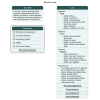Assessment of a Simulated Case-Based Measurement of Physician Diagnostic Performance
- PMID: 30646211
- PMCID: PMC6484555
- DOI: 10.1001/jamanetworkopen.2018.7006
Assessment of a Simulated Case-Based Measurement of Physician Diagnostic Performance
Abstract
Importance: Diagnostic acumen is a fundamental skill in the practice of medicine. Scalable, practical, and objective tools to assess diagnostic performance are lacking.
Objective: To validate a new method of assessing diagnostic performance that uses automated techniques to assess physicians' diagnostic performance on brief, open-ended case simulations.
Design, setting, and participants: Retrospective cohort study of 11 023 unique attempts to solve case simulations on an online software platform, The Human Diagnosis Project (Human Dx). A total of 1738 practicing physicians, residents (internal medicine, family medicine, and emergency medicine), and medical students throughout the United States voluntarily used Human Dx software between January 21, 2016, and January 15, 2017.
Main outcomes and measures: Internal structure validity was assessed by 3 measures of diagnostic performance: accuracy, efficiency, and a combined score (Diagnostic Acumen Precision Performance [DAPP]). These were each analyzed by level of training. Association with other variables' validity evidence was evaluated by correlating diagnostic performance and affiliation with an institution ranked in the top 25 medical schools by US News and World Report.
Results: Data were analyzed for 239 attending physicians, 926 resident physicians, 347 intern physicians, and 226 medical students. Attending physicians had higher mean accuracy scores than medical students (difference, 8.1; 95% CI, 4.2-12.0; P < .001), as did residents (difference, 8.0; 95% CI, 4.8-11.2; P < .001) and interns (difference, 5.9; 95% CI, 2.3-9.6; P < .001). Attending physicians had higher mean efficiency compared with residents (difference, 4.8; 95% CI, 1.8-7.8; P < .001), interns (difference, 5.0; 95% CI, 1.5-8.4; P = .001), and medical students (difference, 5.4; 95% CI, 1.4-9.3; P = .003). Attending physicians also had significantly higher mean DAPP scores than residents (difference, 2.6; 95% CI, 0.0-5.2; P = .05), interns (difference, 3.6; 95% CI, 0.6-6.6; P = .01), and medical students (difference, 6.7; 95% CI, 3.3-10.2; P < .001). Attending physicians affiliated with a US News and World Report-ranked institution had higher mean DAPP scores compared with nonaffiliated attending physicians (80 [95% CI, 77-83] vs 72 [95% CI, 70-74], respectively; P < .001). Resident physicians affiliated with an institution ranked in the top 25 medical schools by US News and World Report also had higher mean DAPP scores compared with nonaffiliated peers (75 [95% CI, 73-77] vs 71 [95% CI, 69-72], respectively; P < .001).
Conclusions and relevance: The data suggest that diagnostic performance is higher in those with more training and that DAPP scores may be a valid measure to appraise diagnostic performance. This diagnostic assessment tool allows individuals to receive immediate feedback on performance through an openly accessible online platform.
Conflict of interest statement
Figures

Similar articles
-
Attending Physician Adherence to a 29-Component Central Venous Catheter Bundle Checklist During Simulated Procedures.Crit Care Med. 2016 Oct;44(10):1871-81. doi: 10.1097/CCM.0000000000001831. Crit Care Med. 2016. PMID: 27336437
-
Teaching the Basics: Development and Validation of a Distal Radius Reduction and Casting Model.Clin Orthop Relat Res. 2017 Sep;475(9):2298-2305. doi: 10.1007/s11999-017-5336-3. Epub 2017 Apr 3. Clin Orthop Relat Res. 2017. PMID: 28374350 Free PMC article.
-
Simulation for Assessment of Milestones in Emergency Medicine Residents.Acad Emerg Med. 2018 Feb;25(2):205-220. doi: 10.1111/acem.13296. Epub 2017 Nov 9. Acad Emerg Med. 2018. PMID: 28833892
-
A Pilot Study to Gauge Effectiveness of Standardized Patient Scenarios in Assessing General Surgery Milestones.J Surg Educ. 2016 Nov-Dec;73(6):e1-e8. doi: 10.1016/j.jsurg.2016.08.012. J Surg Educ. 2016. PMID: 27886969 Review.
-
Effect of January vacations and prior night call status on resident ABSITE performance.J Surg Educ. 2013 Nov-Dec;70(6):720-4. doi: 10.1016/j.jsurg.2013.06.013. Epub 2013 Jul 12. J Surg Educ. 2013. PMID: 24209647 Review.
Cited by
-
Improving diagnosis by feedback and deliberate practice: one-on-one coaching for diagnostic maturation.Diagnosis (Berl). 2021 Feb 3:10.1515/dx-2020-0129. doi: 10.1515/dx-2020-0129. Online ahead of print. Diagnosis (Berl). 2021. PMID: 33544476 Free PMC article.
-
Peabody's Paradox: Balancing Patient Care and Medical Education in a Pandemic.J Grad Med Educ. 2020 Jun;12(3):264-268. doi: 10.4300/JGME-D-20-00251.1. J Grad Med Educ. 2020. PMID: 32595841 Free PMC article. No abstract available.
-
A Pilot Study on the Feasibility of Developing and Implementing a Mobile App for the Acquisition of Clinical Knowledge and Competencies by Medical Students Transitioning from Preclinical to Clinical Years.Int J Environ Res Public Health. 2022 Feb 27;19(5):2777. doi: 10.3390/ijerph19052777. Int J Environ Res Public Health. 2022. PMID: 35270471 Free PMC article.
-
Impact of take-home messages written into slide presentations delivered during lectures on the retention of messages and the residents' knowledge: a randomized controlled study.BMC Med Educ. 2020 Jun 3;20(1):180. doi: 10.1186/s12909-020-02092-7. BMC Med Educ. 2020. PMID: 32493318 Free PMC article. Clinical Trial.
-
Automating hybrid collective intelligence in open-ended medical diagnostics.Proc Natl Acad Sci U S A. 2023 Aug 22;120(34):e2221473120. doi: 10.1073/pnas.2221473120. Epub 2023 Aug 14. Proc Natl Acad Sci U S A. 2023. PMID: 37579152 Free PMC article.
References
-
- ABIM 2020 Report. A vision for certification in internal medicine in 2020. https://www.abim.org/news/assessment-2020-task-force-findings.aspx. September 2015.

